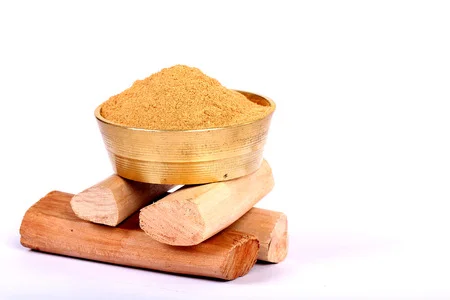Project Report For Sandalwood Powder
Introduction
Project report for Sandalwood Powder is as follows.
Sandalwood is an aromatic evergreen tree of the genus Santalum with a hefty, yellow, and fine-grained wood that has long been used in perfumes, fragrances, and colognes. Sandalwood oil and powder are widely used for their impressive beauty and health benefits.
It is the world’s second most expensive wood, after African Blackwood, and its distinct scent is highly valued in ancient medicines for its numerous therapeutic properties. Sandalwood is incredibly pricey and is used to create many different things. Indian sandalwood has been used for both beauty and medicinal purposes, making it possibly the most valuable wood on earth. Due to its expensive aromatic heartwood, there is a significant international demand for it.

Product & Application of Sandalwood Powder
There are several uses for sandalwood, including the production of powder, sandalwood oil, cosmetics, and Ayurvedic medicines. Sandalwood is ground into a fragrant powder. It mostly serves religious functions like puja. In religious ceremonies such as puja, it is put on the forehead as a tilak. It treats rashes, acne, blackheads, and facial breakouts when applied to the skin as a paste.
Additionally, the paste Moisturises and helps the skin sparkle. The powder is also useful for baby care, fragrance freshness, and cooling & healing. The primary component of sandalwood oil, soap, agarbatti, perfume, and other products is sandalwood powder.
Project Report Sample On
Sandalwood Powder
Get Completely Custom Bankable Project Report
Properties of Sandalwood
The following section discusses the health benefits of sandalwood.
- It may be used because of its antioxidant properties.
- It could have anti-inflammatory effects.
- It may have anti-proliferative (cell-growth-inhibiting) properties.
- It could have antimicrobial properties.
Manufacturing Processing
Sandalwood trees are harvested between 30 and 60 years of age. The sandal tree is thought to grow slowly. Under ideal soil and moisture conditions, it grows at a rate of at least 5 cm of girth every year. Around age ten, the heartwood begins to form. The hard wood is chipped, then ground into powder in a mill or machine after the soft wood has been removed. To obtain the grind materials, it is pulverized later. These powders are labelled and come in various pack sizes.
Market Potential Of Sandalwood Powder
The size of the Sandalore market was estimated at US$ 109.67 million in 2021, and from 2022 to 2029, total revenue is anticipated to increase at a CAGR of 7.60%, or nearly US$ 197.05 million.
Expenses

Product Cost Breakup

Reveneue Vs Expenses

Market Trend

The Sandalore Market is expected to be worth US$ 197.05 million by 2029. Sandalore, a synthetic sandalwood odorant, is used in skin care products, emollients, and perfumes because it smells like sandalwood. This report focuses on the various segments of the Sandalore market (Product, End-Use, and Region).
This report thoroughly investigates the leading industry players and regions (North America, Asia Pacific, Europe, Middle East & Africa, and South America). It’s a thorough examination of today’s rapid advances in a variety of fields. Facts and figures, visualisations, and presentations are used to highlight the primary data analysis from 2017 to 2021.
This report examines Sandalore’s market drivers, restraints, opportunities, and challenges. Sandalore is widely used in the cosmetic industry due to its high boiling point, insolubility in water, large molecular weight, and solubility in alcohol.
The sandalore market is expanding due to an increase in end-use products such as skin cleaning agents, creams and lotions, liquid shampoos, tablets and liquid soaps, antiperspirants such as deodorants, fabric softeners, incense talcum powder, and detergent powder. The market is expanding as a result of an increase in product launches from major manufacturers, particularly in the personal care, toiletries, and cosmetics categories.
